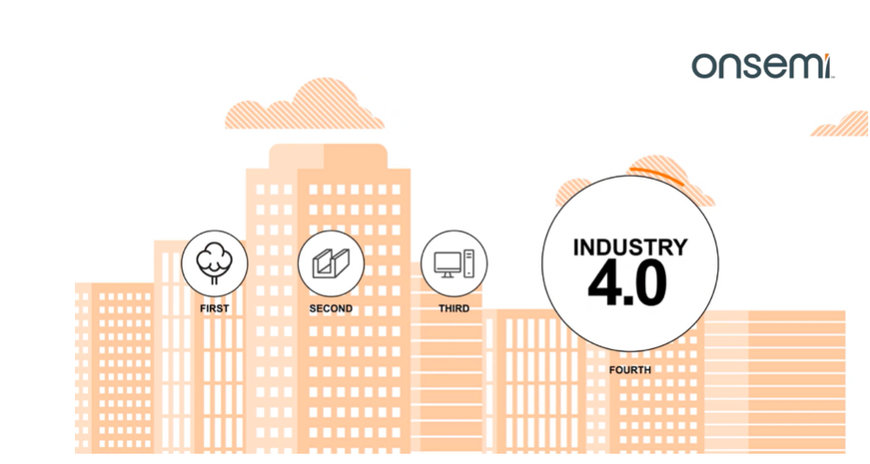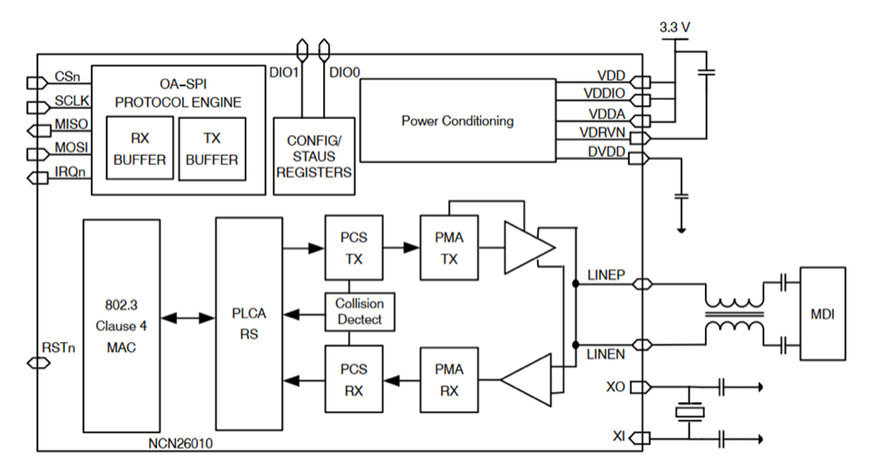Deterministic Operation Opens New Ethernet Applications
By Arndt Schuebel, Technical Marketing / Application I4.0 wired connectivity, onsemi.

Industry 4.0 drives different challenges for networking
New network protocols are normally developed to deliver greater data throughput although there are other aspects to performance. For example, sensors and actuators in factories / buildings require little data but have other requirements to operate “on the edge.”
Currently, there are multiple protocols for these devices available and in use, which creates complexity and cost for users. To address this, the IEEE set up a task force to look at ways of using a single pair of Ethernet (SPE) cables to deliver data at speeds up to 10 Mb/s. If successful, there would be benefits in factories (Industry 4.0), automotive and other applications.
The IEEE project resulted in the IEEE 802.3cg standard being released in 2019, delivering the advantages of SPE to “edge” applications. In this article, we will look at how 10BASE-T1S was further developed from this standard and consider some of the technology available to support it.
The Need for Determinism
SPE has existed in point-to-point configurations for some time but, despite high data rates, these incarnations lacked the determinism required by many applications to ensure prompt and repeatable operation.
Ethernet is based upon carrier-sense multiple access with collision detection (CSMA/CD) to decide which node gains access to the shared network medium (cable). If a collision is detected, transmitting nodes stop transmitting for a random amount of time before trying again. This process avoids data corruption due to collisions; however, these random latencies make any time guarantees impossible.
Think of it like meeting around a table. If two people speak at the same time they stop talking, count to a random number and try again. You can see how some people may have to wait a long time to speak again, and this is the challenge for nodes in non-deterministic systems.
For industrial and automotive applications, determinism had to be built in – braking or steering systems that have a random delay would be extremely dangerous. While 10BASE-T1S (a network protocol designed to enable multi drop data communication at rates of up to 10Mb/s over cables up to 25 meters in length) was being developed, this was a key goal.
Known as Physical Layer Collision Avoidance (PLCA), the new media access protocol guarantees the maximum amount of latency in a half-duplex multidrop network. A PLCA transmission cycle is initiated by a coordinator note (Node 0) sending a beacon signal, allowing all other network nodes to synchronize. The next step is to provide an offer to transmit to the first node (Node 1). If there is no data to send, then the offer is sent to Node 2 and so on, until every node has received one or more transmit opportunities. Once the cycle is complete, it simply starts again with the transmission of another beacon signal, and then offers to transmit.
So that the data bus cannot be monopolized by a single node, the number of frames per transmit opportunities can be set via the ‘burst mode’ setting. The default is one frame per transmit opportunities, but this can be set as high as 128 frames, depending upon the application’s needs. It is not possible for data collisions to happen, this setting has no impact on overall throughput.

The PLCA approach ensures 10BASE-T1S is deterministic
A normal Ethernet cable contains four pairs of twisted wires which are generally considered too expensive for low-cost installations. The cable thickness and weight can make installation difficult. When 10BASE-T1S was developed, it was based upon a single twisted pair, thereby significantly lowering the cost and easing installation.
Industrial environments are often harsh in terms of temperature as well as being electrically noisy due to the heavy machinery and switchgear, all of which are a challenge for networking.
Early incarnations of Ethernet were not designed for electromagnetic compatibility (EMC), but since 10BASE-T1S was developed specifically for industrial usage, reliable operation in harsh industrial environments was a key design goal.
The goal was met and 10BASE-T1S offers better EMC performance than most protocols. It is also able to meet Class 3 IEC61000-4-6 EMI requirements when transmitting over unshielded single-pair cables. This is a side benefit of PLCA as the elimination of collisions allows for the use of advanced techniques to identify signals among a high level of electrical noise.
- 10BASE-T1S in Industrial Edge Applications
- 10BASE-T1S offers several benefits to equipment designers and operators within the industrial space which includes:
- Temperature and pressure sensors
- Robotic and HVAC actuators
- Fans
- Voltage monitors
- Power converters
- Along with other modules that are connected to control cabinets at low data rates.
Legacy technologies such as RS-485 and UART as well as FieldBus can be replaced with a single cable multi drop system. One benefit is in maintenance as devices can be removed or replaced without impacting performance or causing the need for costly downtime. As everything is running on a single cable with a single protocol, equipment such as gateways, switches and protocol translators are no longer needed, saving cost, space and power usage.
Multifunctional MACPHY Transceiver
In most cases, 10BASE-T1S Ethernet PHY controllers simply deliver the physical layer functions required to transmit and receive data over an unshielded single-pair cable. It is normal that they also include a media independent interface (MII) to communicate with a media access controller (MAC).
onsemi’s newly developed IEEE 802.3cg compliant Ethernet transceiver (NCN26010) takes a different approach by combining a MAC, a PLCA reconciliation sublayer (RS) and a 10BASE−T1S PHY in a single package, thereby eliminating the two-tiered approach of other solutions.

The NCN26010 integrated 10BASE-T1S transceiver from onsemi
Therefore, the NCN26010 includes everything necessary to deliver the physical layer functions required to transmit and receive data over a single unshielded twisted pair (UTP) and communicate with a host MCU via the Open Alliance MACPHY SPI protocol. As the PHY and MAC are integrated, NCN26010-based 10BASE-T1S Ethernet is compatible with sensors and other industrial devices with mid- to low-end MCUs where there is no integrated MAC. For system designers, the result is reduced complexity and the ability to reconfigure nodes once the system has been installed.
Designed for use in electrically noisy factory environments, the NCN26010 has an enhanced noise immunity mode with superior bit error rate (BER) performance that meets the IEC6100-4-6 conducted immunity test. As a result, the NCN26010 can support up to eight nodes over cable lengths of up to 50m (meeting the IEEE 802.3cg standard only requires 25m). Additionally, reduced capacitance on the line pins of the device enables up to 40 nodes to be connected to a single 25m single-pair cable, exceeding the IEEE 802.3cg requirements by a factor of 5.
By adopting Ethernet’s layered approach, changing to the PHY within the NCN26010 does not affect upper layers – making software maintenance simpler and lower cost. Recognizing the need for compact solutions, the transceiver is supplied in either a 4 mm x 4mm QFN32 or a 5mm x 5mm TQFP32 package. It is ideally suited to use in industrial & factory applications and also building automation, street lighting, rail transportation and multiple automotive applications.
Ethernet Meets the Needs of Modern Applications
Originally conceived as a wireless network protocol for connecting computers and peripherals in offices, Ethernet has become the most popular networking standard globally and is used in many more applications that originally thought possible. With the rollout of 10BASE-T1S, Ethernet now adds more applications, including automotive, industrial and edge computing, due to its new multi-drop, deterministic operation.
www.onsemi.com

